| THIS WEEK'S ARTICLES |
| John Murphy's Market Message |
| STOCKS END WEAK DECEMBER UNDER PRESSURE: NASDAQ HAS REACHED ITS AUTUMN LOW; SECTOR RANKING REMAINS DEFENSIVE |
| by John Murphy |
STOCKS END YEAR UNDER PRESSURE...
Little has changed since the last message written a couple of weeks ago. At that point, major stock indexes had failed a test of overhead resistance levels and were starting to weaken. They've weakened even further since then. Chart 1 shows the Dow Jones Industrial Average ($INDU) trading well below resistance at its August peak and sitting on its 200-day moving average (MA). The other two major stock indexes have performed much worse. Chart 2 shows the S&P 500 index ($SPX) trading below its 50-day MA after failing a test of its 200-day MA line earlier this month. The tech-driven Nasdaq market has been the weakest of the three.
Chart 3 shows the Nasdaq Composite ($COMPQ) having already reached the lows formed during October and November. From a seasonal standpoint, stocks have a history of ending the year on a stronger note. That hasn't happened this year with stocks losing ground during December. Sector rotations also remain in a more defensive mode.
 CHART 1: THE DOW JONES INDUSTRIAL AVERAGE IS TRADING BELOW RESISTANCE. Chart source: StockCharts. For illustrative purposes only. CHART 1: THE DOW JONES INDUSTRIAL AVERAGE IS TRADING BELOW RESISTANCE. Chart source: StockCharts. For illustrative purposes only.
 CHART 2: S&P 500 TRADING BELOW ITS 50- AND 200-DAY MOVING AVERAGE. Chart source: StockCharts. For illustrative purposes only. CHART 2: S&P 500 TRADING BELOW ITS 50- AND 200-DAY MOVING AVERAGE. Chart source: StockCharts. For illustrative purposes only.
 CHART 3: THE NASDAQ COMPOSITE IS ALREADY SITTING AT ITS LOWS. Chart source: StockCharts. For illustrative purposes only. CHART 3: THE NASDAQ COMPOSITE IS ALREADY SITTING AT ITS LOWS. Chart source: StockCharts. For illustrative purposes only.
Sector Rankings Remain Defensive
Chart 4 shows sector performance during December is still in a defensive mode. The month's three top sectors are Utilities, Health Care, and Consumer Staples. All three are defensive in nature. The two weakest sectors are Consumer Discretionary and Technology. Technology weakness explains the poor performance in the Nasdaq. Weakness in Consumer Cyclicals is especially worrisome.
 CHART 4: S&P SECTOR PERFORMANCE. The top three sectors in December 2022 are Utilities, Health Care, and Consumer Staples. This indicates that investors are in defensive mode. Chart source: StockCharts. For illustrative purposes only. CHART 4: S&P SECTOR PERFORMANCE. The top three sectors in December 2022 are Utilities, Health Care, and Consumer Staples. This indicates that investors are in defensive mode. Chart source: StockCharts. For illustrative purposes only.
Consumer Staples vs. Cyclicals
Chart 5 compares the relative performance of Consumer Discretionary Select Sector SPDR (XLY) and Consumer Staples Select Sector SPDR (XLP) over the last year. What's especially noteworthy is their different paths during the fourth quarter. While economically-sensitive consumer discretionary stocks (XLY) have fallen to new lows, defensive consumer staples (XLP) have had a relatively strong fourth quarter. That's just another sign that the stock market is ending the year on weak technical footing. And that doesn't show much optimism heading into the new year.
 CHART 5: CONSUMER STAPLES VS. CONSUMER DISCRETIONARY. Consumer Staples is ending on a stronger note than Consumer Discretionary. Chart source: StockCharts. For illustrative purposes only. CHART 5: CONSUMER STAPLES VS. CONSUMER DISCRETIONARY. Consumer Staples is ending on a stronger note than Consumer Discretionary. Chart source: StockCharts. For illustrative purposes only.
|
| READ ONLINE → |
|
|
|
|
|
| The Canadian Technician |
| When Should We Start To Get Bullish? |
| by Greg Schnell |
The market is a relentlessly evolving ecosystem that bubbles up and retreats in different areas of the market at any given time. It is very important to be aware of when the trend changes under the surface. I have been cautious through December, as my calculations suggested avoiding the market.
The small pockets of success in October and November have been overrun by the selling, creating a down move on the indexes. When the markets turn higher, I like to be ready. This particular week has thin trading volumes, but it is also interesting that some of my calculations are starting to improve.
We look at the charts and data every day, so, as the market changes, we can react. If I was bearish last week, it was because the data continued to suggest that. Only the market is right, and our plan is to be involved when the market information changes. I will change with the data.
The Nasdaq stock market is hanging by fingernails at the lows from October and November. It is easy to see on a 60-minute line chart.
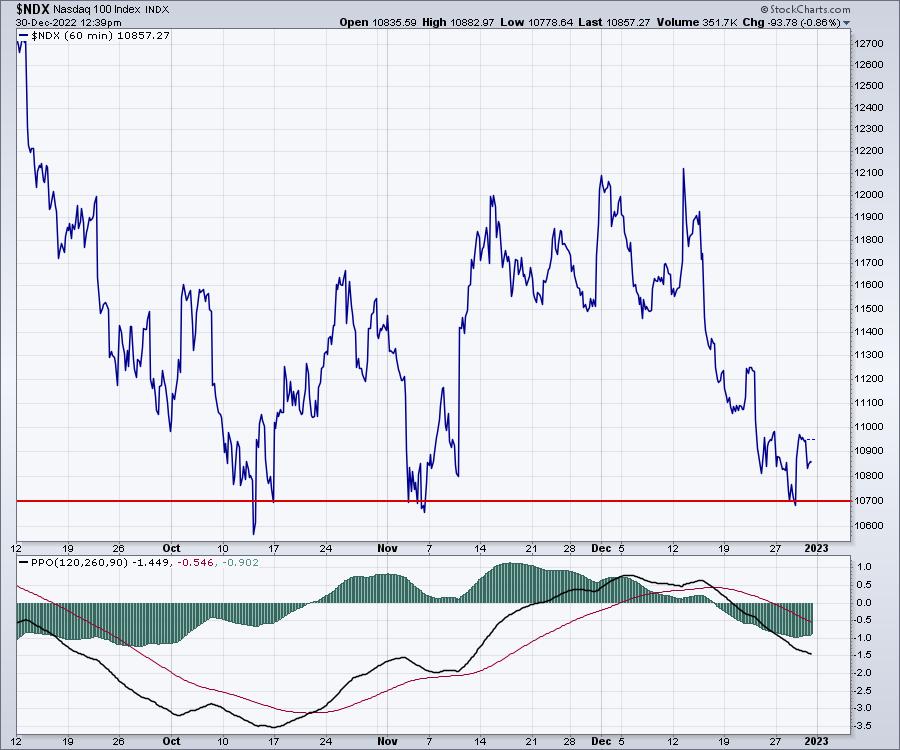
One of the things I am starting to notice is that a few of the tech names are more resilient at this juncture than they were at prior lows by the index.
Here's an example. Shopify (SHOP) was a stock market darling as it exploded higher in 2020 and 2021. 2022 has been a different story. Here are a few things to note:
- The SCTR ranking is starting to kick up for the first time in a while.
- The full stochastic surge looks like a change in trend, as it went to the top of the range and is now pulling back to the 50% level.
- The stock price has built an eight-month base with three drives to a low. Now the stock is holding above the prior lows, while the Nasdaq index is all the way down to the lowest levels.
- Volume has been declining on this December selloff, rather than expanding like it did on the way down.
- The percentage price oscillator (PPO) momentum indicator is making a higher push and appears to have built a base as well. As it pauses here, can it turn and go higher?
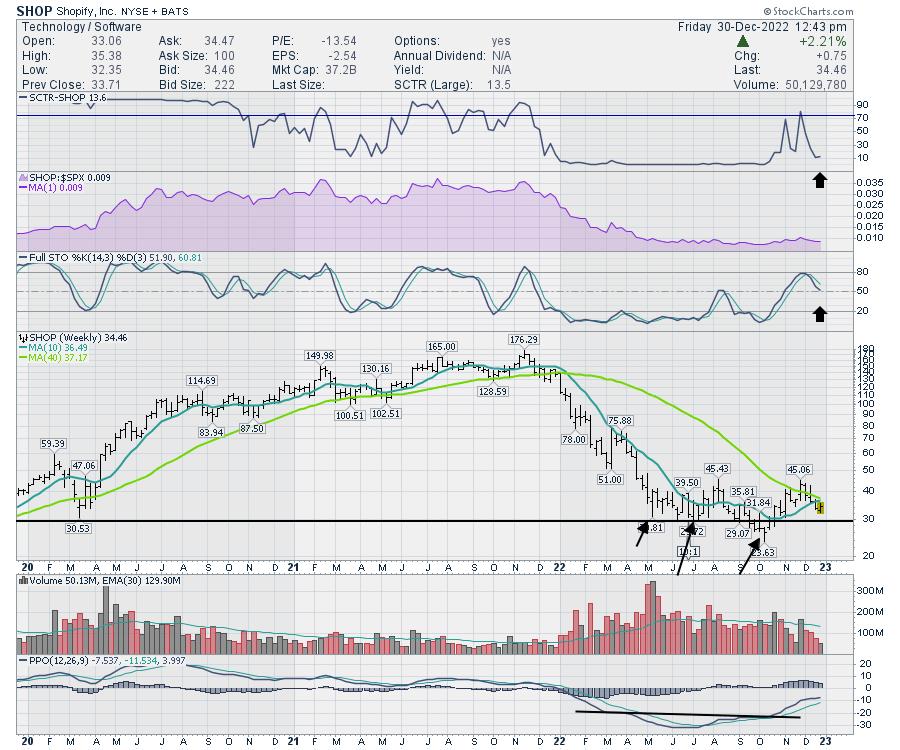
EBAY: A Strong Retailer in 2008–2009
Let me take you to another historical stock pattern that was a former leader and built an important base back at the 2009 low before expanding to the upside. This type of price action is also a Wyckoff base structure that Bruce Fraser talks about. This basing pattern shows how the shareholders are no longer willing to sell, and anyone who has sold ran out of patience. The six-month period really exhausts the sellers.
EBAY topped along with the S&P 500 index ($SPX) in October 2007. It sold off 80% before bottoming. Check out some of the indicator signals and how similar they are to the current setup in SHOP.
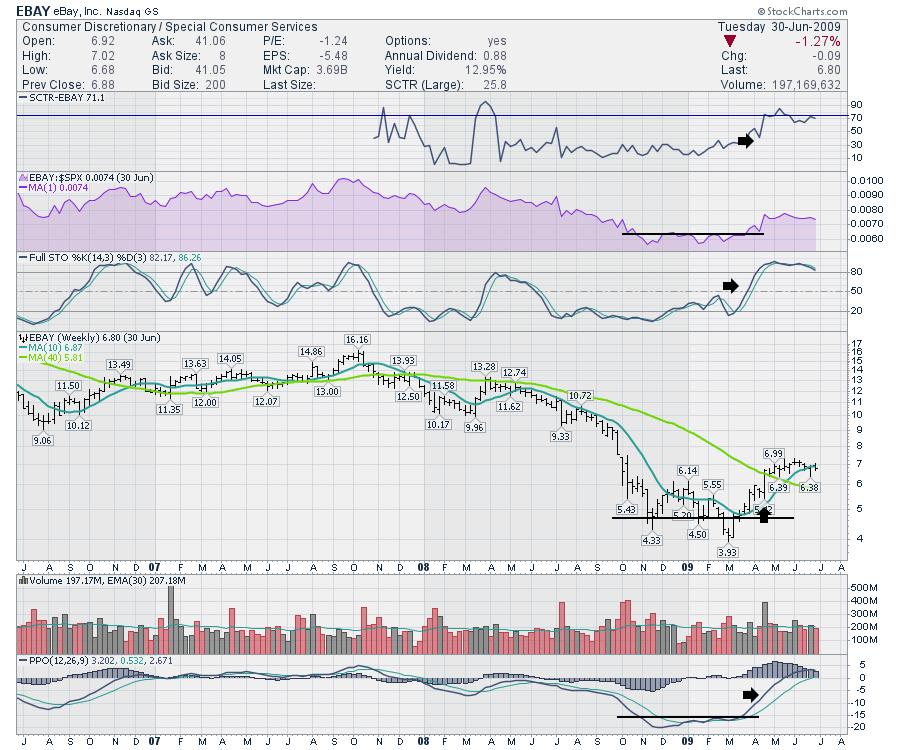
To me, they look similar and my underlying market condition charts are trying to improve. This surprises me as I expect 2023 to be a mess of a year. However, when a rally starts, I want to be ready. What if it ends up being the major low?
2023 Outlook
It always looks darkest before dawn. My end-of-year reviews on the Market Buzz show covering retail and commercial business look bleak. None of us know what next year will bring, but it's important to be ready for whatever comes. Rarely will the market low be obvious. If you participate in all of them, we can be sure to be invested as the market accelerates higher. However, you must also be diligent in protecting our capital in case the rally collapses.
As an example, if you thought being in the market at the October lows was timely, and exiting in November before the market fell was helpful, then you might enjoy our content. Now that the Nasdaq has retested the prior low, maybe we can rally from here?
That's the type of information we provide to clients at Osprey Strategic. As the market conditions continue to improve, I'll be putting my money to work, regardless of my long-term view. Pretty sure my buying won't change the trend, but SHOP has what I like to see on a chart. The chart is the reason I am interested here, but, if the broader market can improve, this is where big gains can be made as a rising tide lifts all boats. Once again.
I'll also be hosting an information session January 10th at 11 ET about the work we do at Osprey Strategic.
Our focus is protecting capital and deploying it at critical times to make the most of the gains. If you'd like to see what we do, there is a $7 offer for the first month on the home page.
|
| READ ONLINE → |
|
|
|
| ChartWatchers |
| Top 5 New Year's Resolutions Every Stock Trader Should Make |
| by Jayanthi Gopalakrishnan |

As the year ends, it's time to think about your New Year's resolutions. But how can you make them last longer than a few weeks? Here's one approach traders and investors can try.
The ball has dropped, the champagne has popped, and you've finally got Auld Lang Syne out of your system. You're ready to move on to the next year—schedule your juice cleanses, sign up with a personal trainer, and buy a new pair of running shoes. This year, you're determined to stick to your resolutions beyond one month. But really, what are the odds of that happening? Well, you know yourself better than anyone.
If you're anything like the average person, you'll break all your resolutions in less than a week. So, instead of being hard on yourself, try a different approach this year. Consider applying your top 5 resolutions to your investment portfolio. Here are 5 to get you started.
 Resolution #1: Give Your Portfolio Adequate Exercise Resolution #1: Give Your Portfolio Adequate Exercise
Like you, your portfolio needs a regular workout. If you let your portfolio become sedentary, some of the assets could become sluggish. So, from time to time, identify the assets that are sitting there not doing much, and think of ways you could get them out of their slump. You may not want to sell those assets because they're still doing your portfolio some good. So how can you add some sizzle to those investments?
Well, try shaking things up a bit by learning about different strategies you could apply in order to squeeze a little more out of those slackers. Have you ever thought of strategies like covered calls or cash-secured puts? How about pairs trading? The new year may be a good time to learn about different strategies that could make your portfolio more active.
 Resolution #2: Feed Your Portfolio a Healthy Diet Resolution #2: Feed Your Portfolio a Healthy Diet
Just like a healthy diet has recommended portions of carbs, protein, and fat, your portfolio should also contain a healthy balance of different asset classes or sectors. You've heard the adage, "don't put all your eggs in one basket." You don't want to have one stock, sector, or asset class overweight your portfolio.
For example, you could allocate your investments between equities, bonds, commodities, and currencies. Within each of these classes are subclasses. Equities can be divided into different sectors or asset classes. Bonds could be divided between government and corporate. Commodities could mean gold, crude oil, or corn. You get the idea.
Find a healthy balance that diversifies your portfolio, meets your investment objective, and maintains your risk tolerance level. Then maintain that balance, because, as you know too well, things change.
 Resolution #3: Limit Your Portfolio's Fat Content Resolution #3: Limit Your Portfolio's Fat Content
Everyone's guilty of reaching for the gooey gastronomical delights and eating the entire box. The same desire extends to even the best traders and investors. When the price of a few stocks keep going up and up and up for no good reason—think meme stocks—it's tempting to bend your trading rules. Everyone else is doing it, so why not you? So you plump up your portfolio with the stocks everyone's chasing.
Then, after a while, your portfolio's gut, er, health starts to suffer.
The problem: If your portfolio ends up being overweight with those few stocks, your portfolio's lifespan may reduce. Resist the temptations the stock market throws at you. If you still end up reaching for these high-fliers, know that it's probably a short-term play. Don't be lured by visions of long-term benefits.
 Resolution #4: Don't Fall In Love With a Stock Resolution #4: Don't Fall In Love With a Stock
Hopefully, you invested in an asset to make a positive return from your investment. But sometimes it's easy to fall in love with a stock because the price keeps going higher and higher. You add more of that stock to your portfolio because your "darling" stock is going to give you even greater returns. But the higher prices go could mean that they have further to fall. And if that stock ends up falling lower and lower, you'll be left heartbroken.
If the asset is no longer meeting your investment objective, there's no reason to hold it close to your heart. Remember, all big losses start out as small ones. Be prepared to let go of the loser.
 Resolution #5: Handle Your Portfolio With Care Resolution #5: Handle Your Portfolio With Care
Every asset in your portfolio is fragile. Even the least risky investment carries a risk that needs to be carefully managed. Proper risk management is what makes an investor or trader shine. So, how do you prevent your portfolio from experiencing catastrophic losses?
Think about how much of a loss you're comfortable taking. That's easier said than done—it's a fine balance between art and science. Maybe you're willing to lose 20% on each trade, or you're willing to lose that much from your entire portfolio at any given time. Maybe your threshold is lower. Only you can decide how much you're willing to lose on a trade. But remember, too low and you may end up with too many losing positions and not enough winners to make it worth your money. And if your threshold level is too high, you may end up with a drawdown that'll wipe out your hard-earned returns.
Managing risks is pretty important for investors and traders but is a topic many don't think about. Treat every asset in your portfolio like a rare collectible. Always think of what could go wrong and how you can protect it by implementing stop orders, thinking about the size of your positions, and diversifying your portfolio adequately.
Sticking To Your New Year's Resolutions
Just like your personal resolutions, your trading resolutions also require discipline. Set up your ChartLists so they reflect your entire portfolio. After a few months, assess how you're doing. If you find yourself breaking your rules—slackers in your portfolio, overweight in one area, falling in love with a stock—it may be time to pause, reassess, and reset. Rinse and repeat at regular intervals. Last, but not least, be ready to take on the market, no matter what it throws at you.
Here's to a healthy and prosperous 2023!

Jayanthi Gopalakrishnan
Director, Site Content
StockCharts.com
Disclaimer: This blog is for educational purposes only and should not be construed as financial advice. The ideas and strategies should never be used without first assessing your own personal and financial situation, or without consulting a financial professional.
|
| READ ONLINE → |
|
|
|
| RRG Charts |
| Looking Back at The Biggest Rotation of 2022 |
| by Julius de Kempenaer |
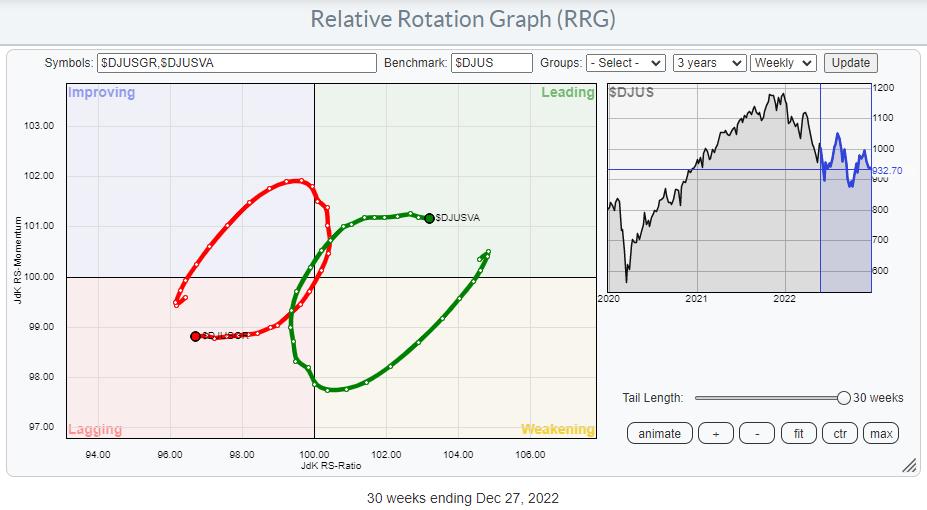
I have been quiet on the video and blog side of things over the past weeks. Still, just before you pop the champagne for a grand New Year's eve celebration, I want to take the opportunity to look back at maybe the most important or dominant rotation that took place in 2022.
I am talking about the Growth vs. Value rotation.
The RRG above shows the last 30 weeks of that rotation, but the story starts at the beginning of the year and the first six months of 2022.
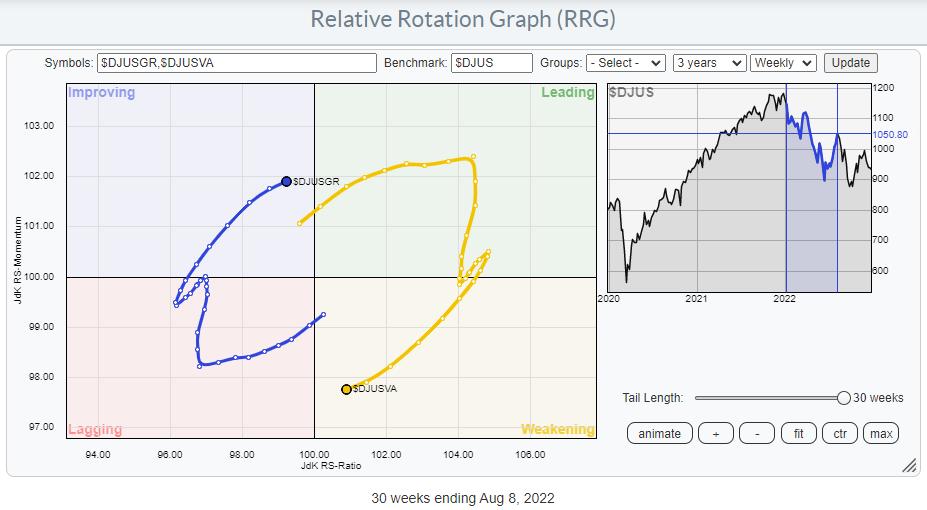
The RRG above captures that rotation. The starting point of the tail is at the start of the year, and the tail ends on August 8. So the year started with Growth entering the lagging quadrant, while Value moved into leading. The dominance of Value over Growth lasted until mid-March, when both tails began to bend. Value started to lose relative momentum and rolled over inside the leading quadrant, while Growth moved opposite inside lagging.
The loss / gain of momentum pushed Value into lagging and Growth into leading at the end of August, but even during this "counter move," value stocks maintained their outperformance vs. Growth. The tails started to bend in the week of March 7 and entered the opposite quadrant in the week of August 29. During that period, Value lost 6% while Growth lost 8.2%.
As you can see on the RRG at the top of this article, the tails started to move in opposite relative momentum directions almost immediately after entering the leading/lagging quadrant at the end of August, re-entering the downtrend of Growth vs. Value. Over the last weeks, the relative momentum (RS-Momentum) has leveled off, but the increase in relative strength is still there, and that is how this relationship will be entering 2023.
A Massive Double Top
The regular price-time chart shows how badly this 1-1 relationship developed through 2022.
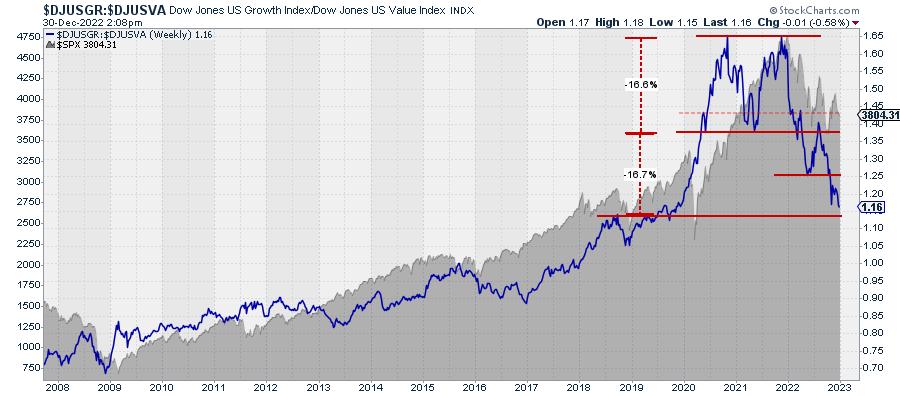
After many years of Growth dominance, this relationship formed a massive double-top formation, confirmed when the ratio dropped below the 2021 bottom near 1.3750. Based on that big reversal pattern, a price target can be calculated either around 1.14 when using a percentage-based move, or around 1.10 when using the absolute difference. Either way, we are not there yet.
And even when this ratio would find support somewhere in the 1.10-1.14 range in the first weeks of 2023, it seems very unlikely that it will revert and immediately start a steep uptrend again. Plenty of resistance levels are waiting to the upside, which will cap any rally for the time being.
If any value can be taken from this ratio as a risk on / risk off metric, the message is pretty clear; we are still in risk off mode for now.
Based on these observations, my take on the markets at the start of the new year will still be very cautious. We may see some pockets of improvement here and there or maybe in the market as a whole ($SPX), but risk remains elevated at the moment.
I wish all a very happy and healthy new year, and I hope to see you as readers of the RRG blog and/or watchers of Sector Spotlight in 2023.
#StaySafe --Julius
|
| READ ONLINE → |
|
|
|
| DecisionPoint |
| Put/Call Ratio is Telling Bears to Watch Out! |
| by Carl Swenlin |
If you're tuned in to the financial media, you may have heard that the put/call ratio is at an extreme. I don't usually pay a lot of attention to this indicator, as it's hard to interpret, but when I looked at it this morning, it certainly provided a wake-up call. Our primary interest is in the CBOE Put/Call Ratio, but I have also included the Equity Put/Call Ratio because it is so far out of its normal range.
To calculate the Put/Call Ratio, divide the number of puts by the number of calls. High readings indicate excessive bearishness, and the current readings are the highest ever. You can see on the chart below that, in the last five years, prior high readings have occurred at important market bottoms.
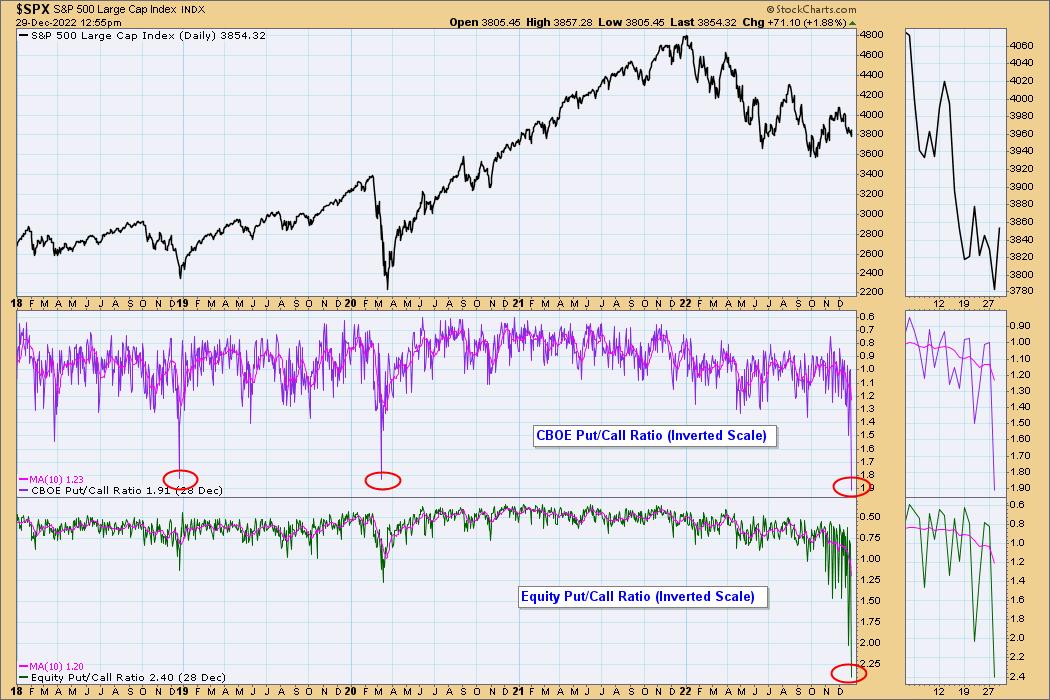
Watch the latest episode of DecisionPoint on StockCharts TV's YouTube channel here!

Historically, stand-out ratio spikes tend to occur at significant price lows. Some exceptions below are as follows:
- The end of the 1994 consolidation
- The extreme ratio reading in 2007 near the bull market top
In addition, the Equity Put/Call Ratio has been at extreme highs for over two months. How and when is one supposed to act on that?
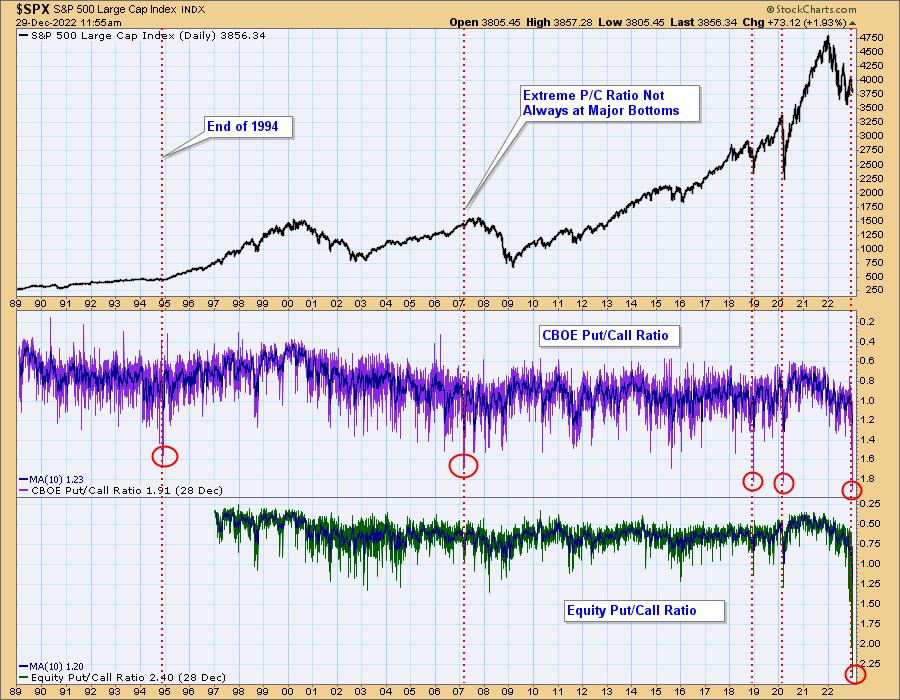
Extreme Sentiment
Current high Put/Call Ratio readings reflect extremely high bearish sentiment. Such extremes typically identify major price lows, and it would pay the bears to stay alert to their increased vulnerability; however, this indicator is not infallible or precise. Be careful, regardless of your inclinations.
--Carl Swenlin
Technical Analysis is a windsock, not a crystal ball. --Carl Swenlin
(c) Copyright 2022 DecisionPoint.com
Helpful DecisionPoint Links:
DecisionPoint Alert Chart List
DecisionPoint Golden Cross/Silver Cross Index Chart List
DecisionPoint Sector Chart List
DecisionPoint Chart Gallery
Trend Models
Price Momentum Oscillator (PMO)
On Balance Volume
Swenlin Trading Oscillators (STO-B and STO-V)
ITBM and ITVM
SCTR Ranking
Bear Market Rules
DecisionPoint is not a registered investment advisor. Investment and trading decisions are solely your responsibility. DecisionPoint newsletters, blogs or website materials should NOT be interpreted as a recommendation or solicitation to buy or sell any security or to take any specific action.
|
| READ ONLINE → |
|
|
|
| PREPARE FOR THE NEW YEAR WITH MARKET VISION 2023 |
 |
| LEARN MORE → |
|
| Top Advisors Corner |
| What's Your Vision for 2023? |
| by John Hopkins |
2022 has come to an end with a collective "Thank Goodness!" There's just no sugarcoating it; 2022 was a brutal year for those who were long stocks. This was particularly true for those who stuck with technology stocks, with the tech-heavy NASDAQ falling 33% for the year.
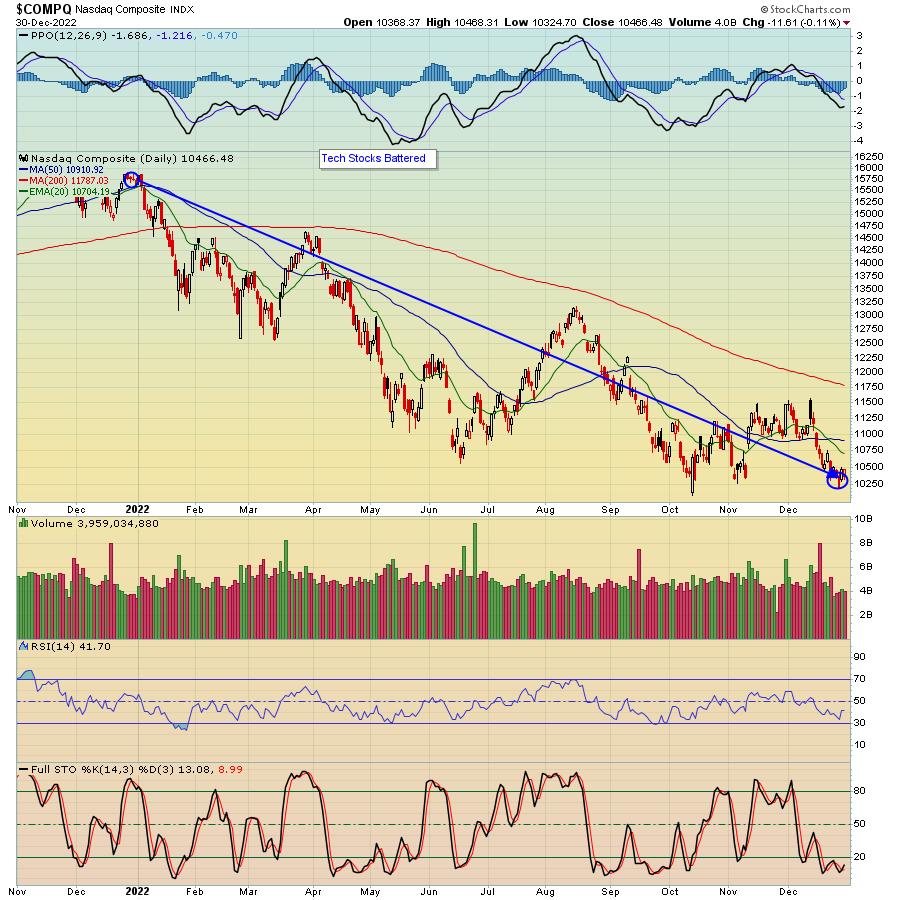
The carving up of tech-related companies reminded many of the dotcom bubble that started in March 2000 and ended in October 2002. It's not that the NASDAQ tanked like it did back in that early 2000s timeframe, but we saw MANY tech stocks fall 50-90% from their respective highs. And the poster child that was carved up by 2/3 in just the past three months - Tesla (TSLA) - has lost close to 70% of its value since its November 2021 high.
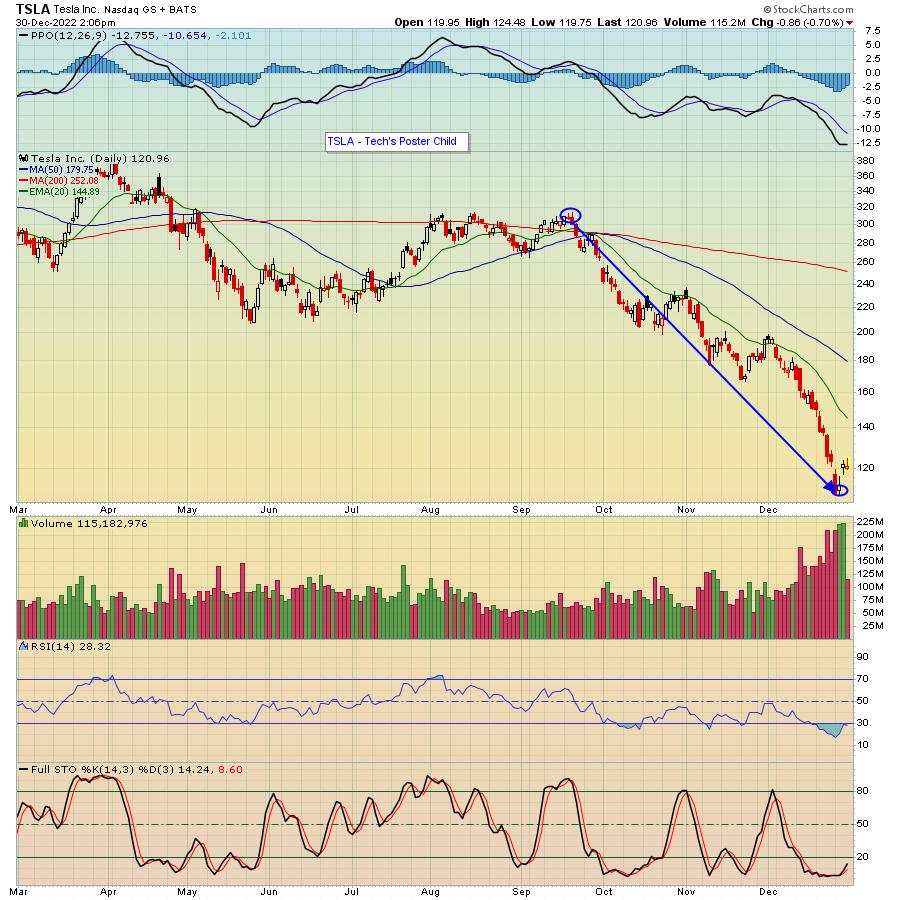
The good news? 2022 is OVER! Which brings me to what might come next as we get ready to enter 2023.
I bring this up as EarningsBeats, in conjunction with StockCharts.com, will be conducting a timely and critically important event on Saturday, January 7: "Market Vision 2023" During this event, our Chief Market Strategist Tom Bowley will be joined by StockCharts.com experts as they discuss how to distinguish between bull and bear markets, the secrets that drive market performance and where equity markets are heading in 2023, including which sectors and industry groups are likely to lead the way. You can learn more about this FREE event and save your seat by clicking here. You DON't want to miss it! And make sure you scroll down and click on the "The Road Ahead: Navigating an Uncertain Market" page to see Tom's track record, which has been awesome.
One thing I've learned in my 35 years of trading is you can't do anything about the past. Once a trade is in the books, it's in the books. But you can take the knowledge you've learned from each and every trade and apply that to future trades for positive outcomes. On that note, here's to a highly prosperous 2023, for one and all!
At your service,
John Hopkins
EarningsBeats.com
|
| READ ONLINE → |
|
|
|
| Mish's Market Minute |
| Weekend Daily: Tips for Trading Profitably in a Bear Market |
| by Mish Schneider |
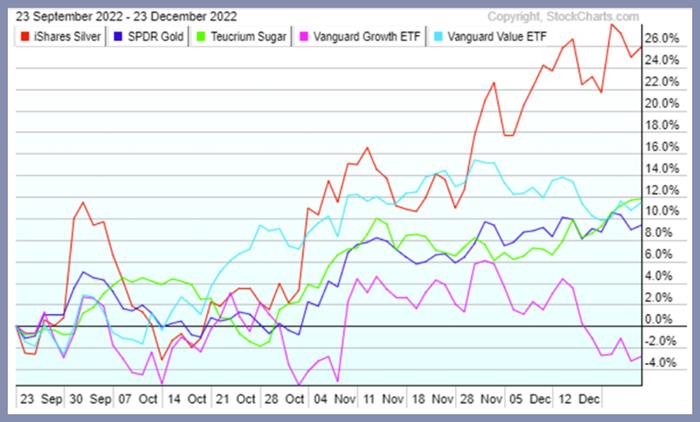
Many investors have had a rough year.
2022 has been characterized by turbulence in financial markets. The Nasdaq Composite, S&P 500 Index, and Russell 2000 are all in bear market territory, while the Dow Jones is the only U.S. index down less than 10% YTD. The performance of U.S. indexes year to date paints a grim picture: Nasdaq (QQQ) -33%, IWM (-23%), SPY (-20%), and DIA (−9%).
Returns for investors range from smaller profits to substantial losses, depending most likely on whether they deployed passive or active strategies and whether any funds are allocated towards alternative assets, like commodities. Rigorous analysis and a trading plan are crucial to trading successfully in bear markets. Commodities are volatile, and it's essential to have stops and profit targets for commodity trades.
The chart below displays the performance of Silver (SLV) at 26%, Sugar (CANE) at 12%, the Vanguard Value ETF (VTV) at 11%, Gold (GLD) at 9%, and the Vanguard Growth ETF at -3% over the last 90 days.
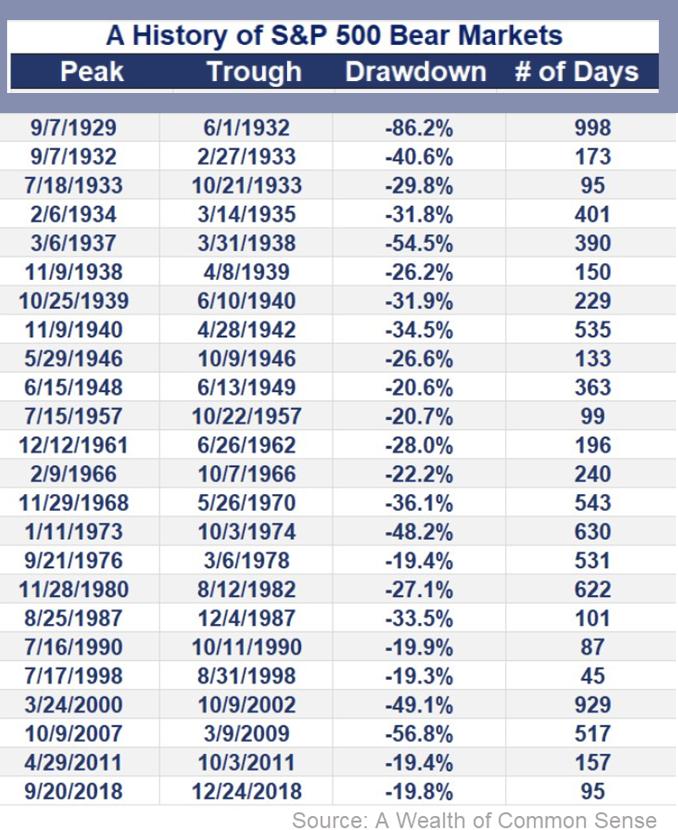
The S&P 500 Index began declining in early January and officially entered a bear market on June 13, 2022. Inflation, higher interest rates, and increased geopolitical tensions all contribute to persistent concerns in the present bear market and will likely continue in 2023.
The Stock Markets at a Glance
- The early 2000s dot-com bubble led to the second-longest bear market in history, which lasted 929 days and a 49.1% decline.
- The March COVID bear market in 2020 was the shortest in history, lasting 33 days and declining 33%.
- Excluding the longest and shortest bear markets, the average length of a bear market is around 330 days—just under one year—and more extended bear markets are closer to two years.
- The average bear market drawdown is approximately 33%.
If today's stock market follows a similar time and price trajectory, the current bear market will last much longer than many people anticipate.
- Market conditions and price action will ultimately decide whether the S&P 500 Index sees lows of 3300, 3250, 3000, 2900, or even lower.
- The S&P 500 Index faces overhead resistance at 4,000, 4,100, 4,150, and, on overhead resistance, 5,000, which will be a number that will be hard to cross for a long length of time.
At MarketGauge, we take advantage of down trends and bear market rallies if we can profitably participate. Despite volatile financial markets this year, we are proud that many of our investments have held firm and have even grown. This provides confidence in our proprietary investment strategies and our ability to manage strategies for maximum returns while limiting drawdowns. And, fortunately, we have seen success with several strategies delivering positive returns despite these trying times. The chart below shows a recent sample of a few profitable trades.
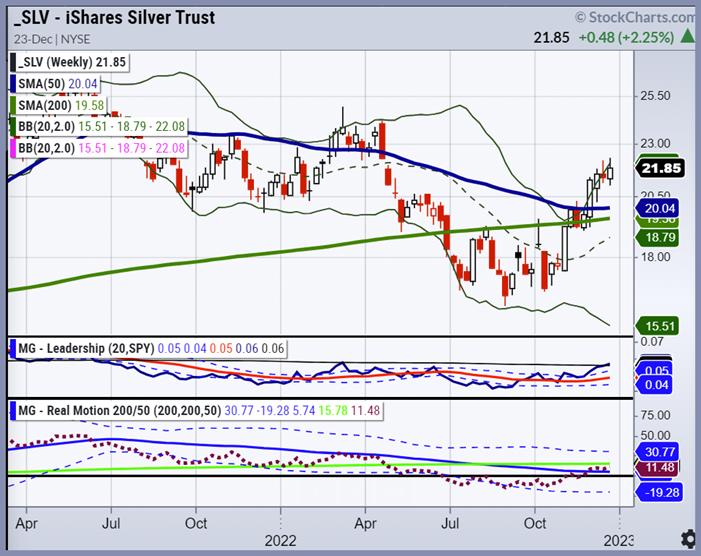
- On August 21, 2022, MarketGauge's Big View members were notified that value had surpassed growth as the outperforming strategy, and continues to lead the price spread (or ratio) of value over growth.
- On August 30, 2022, Mish published "Smart investors know the importance of inflation protection".
- Mish wrote a previous column, "Is Silver About to Outshine Gold?", on September 20, 2022.
- As 2022 draws to a close, it's worth taking stock of several of her recent insights, Mid-September column highlights.
- Mish has written extensively on sugar over the last several years. She recently penned an additional article on sugar, "This Commodity Will Sweeten Your Returns", in early December.
Rigorous analysis and a well-crafted trading plan are crucial to trading success in bear markets. It also helps to have multiple decades of trading experience at your fingertips and proven trading indicators to guide you.
As 2023 approaches, it's helpful to keep in mind the lessons of the past while focusing on executing risk-managed trades that are profitable today, like silver, as an example highlighted below.
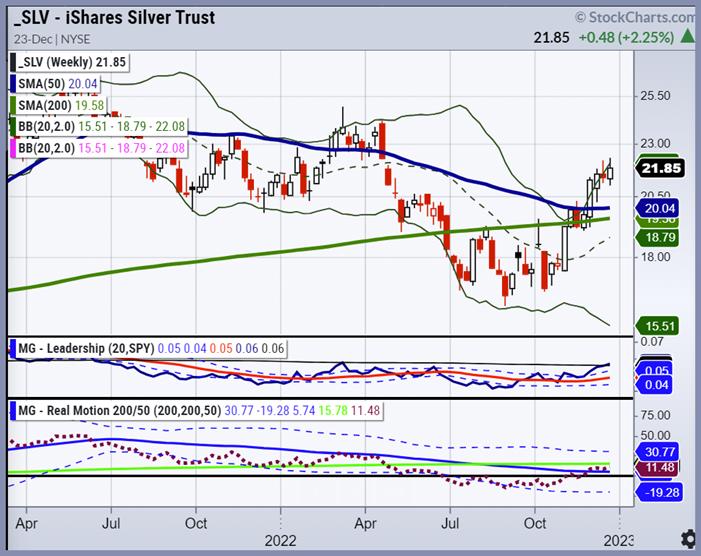
If you're interested in learning more about how MarketGauge can help you trade with an edge, contact Rob Quinn, our Chief Strategy Consultant, who can provide more information about Mish's Premium trading service and other trading strategies we offer with a complimentary one-on-one consultation.

"I grew my money tree and so can you!" - Mish Schneider
Get your copy of Plant Your Money Tree: A Guide to Growing Your Wealth and a special bonus here.
Follow Mish on Twitter @marketminute for stock picks and more. Follow Mish on Instagram (mishschneider) for daily morning videos. To see updated media clips, click here.
Mish in the Media
In this appearance on Business First AM, Mish discusses why she's picking Nintendo (NTDOY).
Mish sits down with Gav Blaxberg for a W.O.L.F podcast on what she has learned as a trader and teacher.
In this appearance on Business First AM, Mish explains how even the worst trade should not be too bad with proper risk management.
In this appearance on Real Vision, Mish joins Maggie Lake to share her view of the most important macro drivers in the new year, where she's targeting tradeable opportunities, and why investors will need to keep their heads on a swivel. Recorded on December 7, 2022.
Mish sits down with CNBC Asia to discuss why all Tesla (TSLA), sugar, and gold are all on the radar.
Read Mish's latest article for CMC Markets, titled "Two Closely-Watched ETFs Could Be Set to Fall Further".
Mish talks the current confusion in the market in this appearance on Business First AM.
Mish discusses trading the Vaneck Vietname ETF ($VNM) in this earlier appearance on Business First AM.
ETF Summary
- S&P 500 (SPY): 380 support, 390 resistance.
- Russell 2000 (IWM): 170 pivotal support, 180 resistance
- Dow (DIA): 330 support, 337 resistance.
- Nasdaq (QQQ): 269 support, 278 resistance.
- Regional Banks (KRE): 53 support, 61 resistance.
- Semiconductors (SMH): Support is 205, resistance 217.
- Transportation (IYT): 211 pivotal support, 222 now resistance.
- Biotechnology (IBB): 130 is pivotal support, 139 overhead resistance.
- Retail (XRT): 57 pivotal support, 63 now resistance. Regained 60.
Mish Schneider
MarketGauge.com
Director of Trading Research and Education
Wade Dawson
MarketGauge.com
Portfolio Manager
|
| READ ONLINE → |
|
|
|
| Don't Ignore This Chart! |
| This Is The Chart To Watch |
| by Tom Bowley |
According to Fidelity.com, Apple, Inc. (AAPL) represents 12.95% and 6.51% of the QQQ and SPY, respectively. The QQQ and SPY are exchange-traded funds that track the NASDAQ 100 and S&P 500 Index respectively. That's a very large weighting, so it would seem to make sense that AAPL's influence will play a big role in the overall stock market direction. That's not great news, considering that AAPL broke down yesterday below a key price support level of 129.50 from the June low:
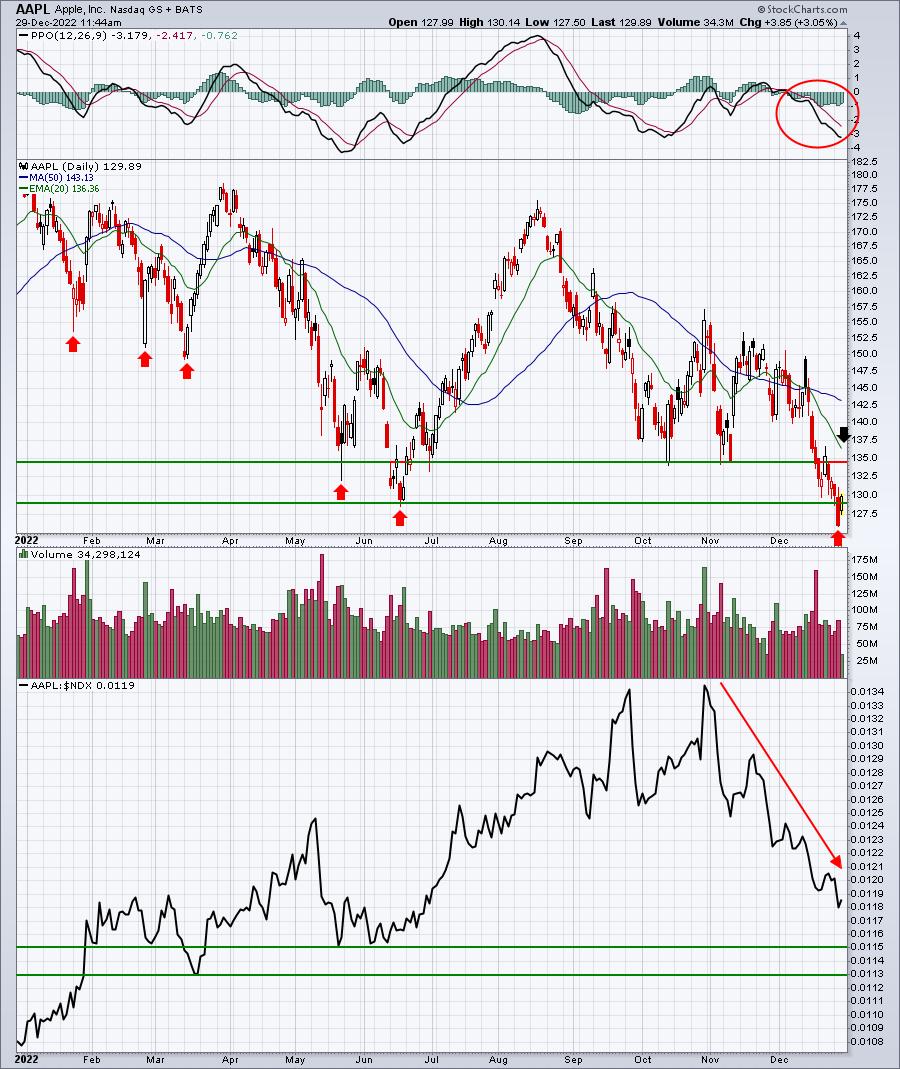
AAPL had established critical price support at 129.50 on June 16. Volume that accompanied this breakdown was heavy, considering that it was the normally light volume period between Christmas and New Year. You can see in the bottom panel that AAPL is completely out of favor and has been underperforming the NASDAQ 100 badly since the beginning of November. If the NASDAQ is to turn higher from here, it's going to need help from AAPL. We must respect this breakdown until AAPL can clear certain upside hurdles. For me, step #1 is to close back above 129.50. You can see that AAPL has recovered more than 3% today and is currently just above 129.50. But where will it close today? Step #2 will be to clear overhead price resistance at 134.50 and the 20-day exponential moving average (EMA), currently at 136.36 and falling rapidly. Time will tell if there's enough buying interest at this level to prompt these moves higher. For now, however, we must assume the AAPL breakdown is not a good signal for the health of the overall market.
While a stock like AAPL certainly carries big influence, there are many other signals you need to watch as 2022 comes to a close and you open the book on 2023. That will be the topic of our fourth annual MarketVision event:
"MarketVision 2023 - The Road Ahead: Navigating An Uncertain Market"
This is a FREE virtual event and one that should be attended by anyone with an interest in U.S. equities. For more information and to register and save your seat, CLICK HERE. We will reach capacity, so please be sure to register TODAY!
Happy trading!
Tom
|
| READ ONLINE → |
|
|
|
| Top Advisors Corner |
| 3rd Year of Presidential Term is Supposed to Be Bullish |
| by Tom McClellan |
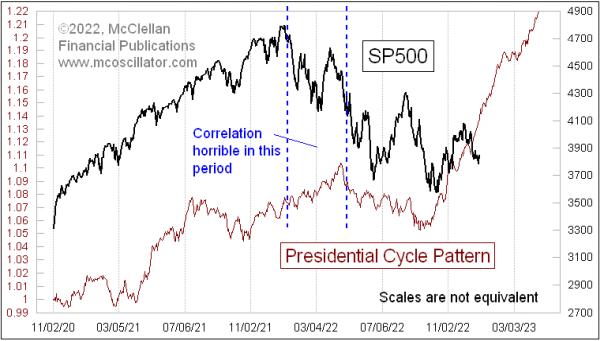
Now that the November 2022 mid-term elections are behind us, the stock market is now in year 3 of the 4-year presidential cycle pattern. Some analysts look at that on a calendar day basis, but I prefer to count the years as beginning on November 1 for this purpose, since the stock market typically responds to whoever gets elected president as soon as it knows the outcome. Usually that is right away, although back in the year 2000, it took all the way until mid-December to settle things.
During a typical 4-year presidential term, the stock market tends to be flattish during the first 2 years. Then the third year is nearly always an up year. The election year can be a lot more iffy, and there are examples of election years turning out really badly, as was the case in 2000 and 2008. But third years are really consistently up, almost all of the time. The notable exceptions were 1931, when the world was in the middle of the Great Depression, and 1939, when the Wehrmacht was marching through Poland. Outside of conditions like those, the third year can usually be counted on to be an up year.
This time may be different, though. The third year up phase did get off to a great start coming out of the October 2022 lows right on schedule. But the rally has faltered in December in a way that the Presidential Cycle Pattern (PCP) in this week's chart does not portray.
The PCP is formulated by chopping up all of the data into 4-year chunks of time, then averaging them together. A few more adjustments are needed to get consistent data. One such adjustment is to equalize all of the years. Up until 1952, the stock market traded on Saturdays; then, in the mid-1960s there was a period when trading was shut down on Wednesday so that the "paperwork" could get caught up (there were no computers then). So to get each 4-year period to be of a consistent length, some trimming of Saturdays or duplication of prior days for uneven holidays is needed.
I also recalculate each 4-year period's prices to reflect a starting value of 1.00 as of Nov. 1 of the election year. That way, higher price levels of recent years won't throw off the calculation of the "average".
The big decline we have seen in December 2022 is definitely out of character for a third year. This does not necessarily mean that the stock market cannot get back into gear with what the PCP shows, but it does say that we are not off to a typical start. And this makes sense, when we consider that the Federal Reserve is not only raising interest rates at the fastest rate ever, it is also selling off its Treasury and mortgage holdings at the fastest rate ever.
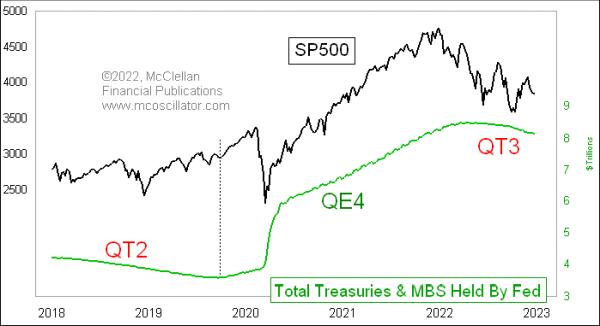
We know that the first round of quantitative tightening (QT1) in the summer of 2008 had a horrible effect for the stock market. QT2 in 2018-19 was not as bad, because it was balanced out by an income tax rate cut enacted in 2017. But QT2 did keep the stock market just moving sideways, until the Fed started buying Treasuries and MBS again in late 2019.
In physics terms, there is always a "balance of forces equation". The motion of the object or particle in question depends on the sum of all of those forces. For 2023, we have the bullish force of the third year of a presidential term being met by the bearish forces of Fed rate hikes AND Fed QT. If ever there were a condition under which the bullish tendency of the third year might not work, this is that time.
|
| READ ONLINE → |
|
|
|
| MORE ARTICLES → |
|
 CHART 1: THE DOW JONES INDUSTRIAL AVERAGE IS TRADING BELOW RESISTANCE. Chart source: StockCharts. For illustrative purposes only.
CHART 1: THE DOW JONES INDUSTRIAL AVERAGE IS TRADING BELOW RESISTANCE. Chart source: StockCharts. For illustrative purposes only. CHART 2: S&P 500 TRADING BELOW ITS 50- AND 200-DAY MOVING AVERAGE. Chart source: StockCharts. For illustrative purposes only.
CHART 2: S&P 500 TRADING BELOW ITS 50- AND 200-DAY MOVING AVERAGE. Chart source: StockCharts. For illustrative purposes only. CHART 3: THE NASDAQ COMPOSITE IS ALREADY SITTING AT ITS LOWS. Chart source: StockCharts. For illustrative purposes only.
CHART 3: THE NASDAQ COMPOSITE IS ALREADY SITTING AT ITS LOWS. Chart source: StockCharts. For illustrative purposes only. CHART 4: S&P SECTOR PERFORMANCE. The top three sectors in December 2022 are Utilities, Health Care, and Consumer Staples. This indicates that investors are in defensive mode. Chart source: StockCharts. For illustrative purposes only.
CHART 4: S&P SECTOR PERFORMANCE. The top three sectors in December 2022 are Utilities, Health Care, and Consumer Staples. This indicates that investors are in defensive mode. Chart source: StockCharts. For illustrative purposes only. CHART 5: CONSUMER STAPLES VS. CONSUMER DISCRETIONARY. Consumer Staples is ending on a stronger note than Consumer Discretionary. Chart source: StockCharts. For illustrative purposes only.
CHART 5: CONSUMER STAPLES VS. CONSUMER DISCRETIONARY. Consumer Staples is ending on a stronger note than Consumer Discretionary. Chart source: StockCharts. For illustrative purposes only.







 Resolution #1: Give Your Portfolio Adequate Exercise
Resolution #1: Give Your Portfolio Adequate Exercise Resolution #2: Feed Your Portfolio a Healthy Diet
Resolution #2: Feed Your Portfolio a Healthy Diet Resolution #3: Limit Your Portfolio's Fat Content
Resolution #3: Limit Your Portfolio's Fat Content Resolution #4: Don't Fall In Love With a Stock
Resolution #4: Don't Fall In Love With a Stock Resolution #5: Handle Your Portfolio With Care
Resolution #5: Handle Your Portfolio With Care





























